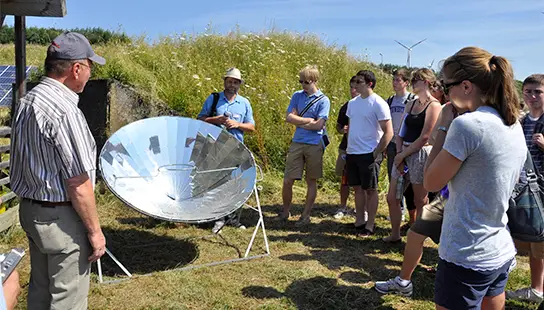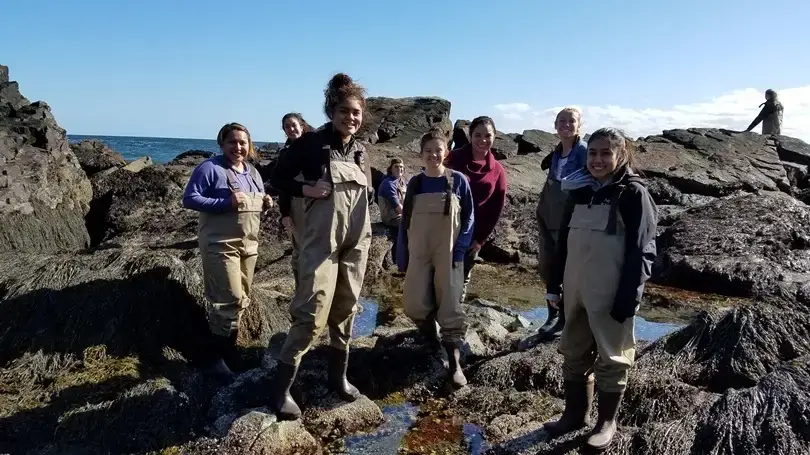Want to know more about the Best School For Environmental Science In the US and make an informed decision? Here is a good place to start.
Looking to study environmental science? Well, you’re in luck because we’ve compiled a list of the best schools for aspiring eco-warriors.
From composting to climate change, these institutions have got you covered. Grab your reusable water bottle, put on your hiking boots, and let’s dive into the world of environmental academia.
Please note that schools are selected based on our criteria (at the end of the article), ranked by the latest acceptance rate.
Table of Contents
#25. University of Colorado, Boulder


- Acceptance rate: 84%
- Average entry score: 1170-1390 SAT or 25-31 ACT
- Student-to-faculty ratio: 17 to 1
- Estimated cost of attendance (tuition and fees): $30,452-$57,702
- Average earning potential for graduates: $46,400 (College Factual)
The University of Colorado, Boulder, is an excellent school for environmental science as it offers several programs and research opportunities in the field.
This school also boasts world-class research centers that provide students with ample opportunities for hands-on learning and collaboration with faculty members.
Plus, the university’s location in the foothills of the Rocky Mountains offers students access to stunning natural landscapes and a thriving outdoor recreation community.
#24. University of Wisconsin, Madison


- Acceptance rate: 53%
- Average entry score: 1300-1480 SAT or 28-32 ACT
- Student-to-faculty ratio: 18 to 1
- Estimated cost of attendance (tuition and fees): $27,484-$55,372
- Average earning potential for graduates: $32,00-$150,000 (UW-Madison)
UW-Madison boasts a science-based education program that focuses on the environment. The bachelor of science degree in environmental science allows students to explore various topics.
Students learn about global warming and how to mitigate the effects it has had on our planet. They also learn how to conduct research, analyze data, and write scientific papers. This type of degree is a valuable asset to any student looking to enter the field of science. It gives them the tools to become leading experts in their chosen fields.
#23. University of Minnesota, Twin Cities


- Acceptance rate: 49%
- Average entry score: 1330-1500 SAT or 27-32 ACT
- Student-to-faculty ratio: 17 to 1
- Estimated cost of attendance (tuition and fees): $23,110-52,088
- Average earning potential for graduates: $50,537 (College Factual)
The university’s Institute on the Environment provides ample opportunities for students to engage in interdisciplinary research. Students also collaborate with faculty members on sustainability initiatives.
This school also offers courses and majors in environmental science, including ecology, conservation biology, and environmental policy. In addition, the city of Minneapolis provides students with an opportunity to learn about environmental science in a real-life laboratory.
#22. University of Florida


- Acceptance rate: 42%
- Average entry score: 1300-1470 SAT or 29-33 ACT
- Student-to-faculty ratio: 18 to 1
- Estimated cost of attendance (tuition and fees): $21,430-$43,708
- Average earning potential for graduates: $63,500 (College Simply)
The University of Florida is a fantastic option for students seeking to pursue a degree in environmental science. This university offers a diverse range of programs that equip students with skills in the field.
UF’s Department of Environmental provides students with a comprehensive education in biology, geology, ecosystems, and environmental challenges.
Furthermore, the University of Florida is dedicated to sustainability and boasts a strong alumni network. This makes it an excellent choice for students who are passionate about environmental science.
Similar articles like this:
- 25 Best Immunology Schools In The US
- 25 Best Microbiology Schools In The US
- 25 Best Education Schools In The US
#21. University of Michigan, Ann Arbor


- Acceptance rate: 26%
- Average entry score: 1360-1530 SAT or 31-34 ACT
- Student-to-faculty ratio: 15 to 1
- Estimated cost of attendance (tuition and fees): $32,272-$69,326
- Average earning potential for graduates: $58,200 (College Simply)
The University of Michigan offers a unique blend of traditional and innovative approaches to environmental science education.
Landscape architecture, Geospatial data sciences, and conservation are some of the specialty areas available to environmental science students. A student-centered program, U-M offers a variety of academic and co-curricular opportunities.
Environmental science students have access to field trips, research opportunities, internships and study abroad options. In addition to their degrees in environmental science, many graduates go on to pursue advanced degrees in law or business administration.
#20. University of California, Berkeley


- Acceptance rate: 17%
- Average entry score: 1415 SAT
- Student-to-faculty ratio: 17 to 1
- Estimated cost of attendance (tuition and fees): $41,878-$71,632
- Average earning potential for graduates: $41,570 (Grad Reports)
Berkeley is renowned for its top-tier environmental science programs, which cover an array of subjects. The faculty, a team of distinguished scholars, are pioneering researchers who are constantly pushing the envelope in the field of environmental science.
UC Berkeley’s student body is composed of highly-motivated individuals who possess a fervent passion for environmental activism. These students are extensively involved in activities such as climate justice rallies, green business start-ups, and other environmentally conscious endeavors.
#19. Washington University St. Louis


- Acceptance rate: 16%
- Average entry score: 1490-1570 SAT or 33-35 ACT
- Student-to-faculty ratio: 7 to 1
- Estimated cost of attendance (tuition and fees): $79,060
- Average earning potential for graduates: $50,470 (Grad Reports)
Washington University St. Louis offers 4 undergraduate environmental majors. Students can choose to study environmental biology, global health and environment, earth science, and environmental policy.
All these majors require students to participate in fieldwork and hands-on learning.
Graduates of Washington University St. Louis’s environmental science majors go on to work as environmental consultants, policy analysts or sustainability managers for companies.
These professionals boast the skills and knowledge to identify environmental issues, formulate solutions and implement those solutions.
#18. University of Southern California


- Acceptance rate: 16%
- Average entry score: 1320-1520 SAT or 30-34 ACT
- Student-to-faculty ratio: 9 to 1
- Estimated cost of attendance (tuition and fees): $60,446
- Average earning potential for graduates: $38,290 (Grad Reports)
USC has implemented several initiatives to reduce its carbon footprint, including a comprehensive recycling program and the use of renewable sources.
This school offers a range of degree programs in environmental science. They provide students with a solid foundation in the principles of environmental science.
USC’s faculty of environmental scientists are world-renowned experts in their fields and conduct innovative research on various environmental issues.
Students at USC can benefit from this expertise through engaging coursework and opportunities to participate in research projects and internships alongside faculty members.
Similar articles like this:
- 25 Best Material Science Schools In The US
- 25 Best Schools For Math In The US
- 25 Best Medical Schools In The US
#17. University of California, Los Angeles


- Acceptance rate: 14%
- Average entry score: 1290-1520 SAT
- Student-to-faculty ratio: 18 to 1
- Estimated cost of attendance (tuition and fees): $16,847-$31,949
- Average earning potential for graduates: $20,140 (Grad Reports)
Students prefer the University of California, Los Angeles (UCLA) for environmental science programs because of its top-notch faculty, cutting-edge research opportunities, and commitment to sustainability.
UCLA’s Environmental Science major is highly interdisciplinary, encompassing fields like ecology, climate science, and environmental policy. The program offers students hands-on experience through fieldwork, internships, and research opportunities at the UCLA Institute of Environment and Sustainability.
Students also benefit from UCLA’s location in Los Angeles, a city with diverse ecosystems and environmental challenges. UCLA’s emphasis on sustainability is evident through its LEED-certified buildings and commitment to reducing its carbon footprint.
#16. Vanderbilt University


- Acceptance rate: 12%
- Average entry score: 1480-1570 SAT or 34-35 ACT
- Student-to-faculty ratio: 8 to 1
- Estimated cost of attendance (tuition and fees): $79,558
- Average earning potential for graduates: $42,770 (Grad Reports)
Vanderbilt is your ideal choice for an environmental science degree if you want to work in corporate sustainability. The university offers well-tailored degrees in both environmental science and natural resource management.
Students take advantage of the university’s state-of-the-art facilities to conduct research on environmental issues. As a result, the university is able to support its students with cutting-edge research opportunities.
The university’s multidisciplinary approach to environmental science attracts students from a variety of different backgrounds. It allows them to benefit from a wide range of perspectives, which is useful when working on real-world problems.
#15. Johns Hopkins University


- Acceptance rate: 11%
- Average entry score: 1510-1570 SAT or 34-35 ACT
- Student-to-faculty ratio: 7 to 1
- Estimated cost of attendance (tuition and fees): $78,657
- Average earning potential for graduates: $74,419 (College Factual)
JHU’s undergraduate environmental science program provides an introductory framework of environmental science, which includes courses in ecology and evolution. At this level, students learn about the scientific method and how to apply it to environmental problems.
JHU’s advanced degrees in environmental science are also popular among graduates. These programs focus on research, especially as it relates to water quality and global climate change.
Experts teach students how to assess environmental issues and develop solutions. The programs provide students with the knowledge and skills needed to work in local, state or federal governments.
#14. Rice University


- Acceptance rate: 11%
- Average entry score: 1490-1570 SAT or 34-35 ACT
- Student-to-faculty ratio: 6 to 1
- Estimated cost of attendance (tuition and fees): $74,110
- Average earning potential for graduates: $28,600 (Grad Reports)
This program brings out the interconnection between science and society, teaching students how to apply their knowledge of the natural world to make a difference in people’s lives. Experienced lecturers and researchers will help you develop a critical eye for scientific inquiry.
The program is designed to encourage outside-the-box thinking, allowing students to push past traditional boundaries of inquiry and discover new ways of understanding their world. Rice University students have gone on to careers in government, science journalism, environmental advocacy and education.
Similar articles like this:
- 25 Best Multidisciplinary Schools In The US
- 25 Best Gerontology Schools In The US
- 25 Best Nursing Schools In The US
#13. Cornell University


- Acceptance rate: 11%
- Average entry score: 1450-1560 SAT or 33-35 ACT
- Student-to-faculty ratio: 9 to 1
- Estimated cost of attendance (tuition and fees): $78,992
- Average earning potential for graduates: $59,120 (Grad Reports)
Cornell University aims to solve the world’s most pressing environmental problems. It does so by providing students with an unparalleled education in the science of the environment. The school offers a major in environmental and sustainability studies.
This program is taught by faculty members who are leaders in their fields. Students can also pursue minors in environmental studies or sustainability, which provide them with a solid foundation for careers in the field of environmental science.
Not only do graduates of the program have a solid understanding of the science behind environmental issues, but they also have a strong sense of how to approach these problems. This is an invaluable skill for anyone who wants to make a difference in this field.
#12. Northwestern University


- Acceptance rate: 9%
- Average entry score: 1440-1550 SAT or 33-35 ACT
- Student-to-faculty ratio: 6 to 1
- Estimated cost of attendance (tuition and fees): $62,391
- Average earning potential for graduates: $42,680 (Grad Reports)
Northwestern University stands out as one of the best schools for environmental science programs due to its strong focus on interdisciplinary education and cutting-edge research.
With world-renowned faculty, state-of-the-art facilities, and a commitment to sustainability, Northwestern provides students with a comprehensive understanding of environmental issues and the tools to tackle them.
Northwestern’s partnerships with local and global organizations provide students with hands-on experience and networking opportunities in the field.
#11. University of Pennsylvania


- Acceptance rate: 9%
- Average entry score: 1460-1570 SAT or 33-35 ACT
- Student-to-faculty ratio: 7 to 1
- Estimated cost of attendance (tuition and fees): $65,790
- Average earning potential for graduates: $42,899 (ZipRecruiter)
With a strong focus on sustainability and a commitment to innovation, the University of Pennsylvania is an ideal choice for students seeking to make a difference in the world of environmental science.
The University of Pennsylvania is an exceptional academic institution that provides students with a well-rounded education in environmental science.
This program offers advanced courses in environmental science, ecology, conservation biology, and climate change. It gives students a deep understanding of our planet’s complex environmental challenges.
#10. Dartmouth College


- Acceptance rate: 9%
- Average entry score: 1449-1560 SAT or 32-35 ACT
- Student-to-faculty ratio: 7 to 1
- Estimated cost of attendance (tuition and fees): $81,662
- Average earning potential for graduates: $38,900-$100,500 (Dartmouth)
Dartmouth prepares students to be thoughtful, dynamic leaders who understand the world. This institution’s environmental science program stands out for its depth.
The curriculum features a combination of core courses, electives and fieldwork. Students complete a capstone project that ties together the skills they learned throughout their education.
Graduates are well-positioned to enter the workforce or pursue advanced degrees. They are equipped with the ability to solve complex problems and communicate effectively.
Similar articles like this:
- 25 Best Schools For Neuroscience In The US
- 25 Best Pharmaceutical Sciences Schools In The US
- 25 Best Astronomy Schools In The US
#9. Duke University


- Acceptance rate: 8%
- Average entry score: 1480-1570 SAT or 33-35 ACT
- Student-to-faculty ratio: 8 to 1
- Estimated cost of attendance (tuition and fees): $84,517
- Average earning potential for graduates: $36,990 (Grad Reports)
Duke University’s environmental science program provides students with comprehensive education, access to cutting-edge research opportunities, and a strong commitment to sustainability.
Duke’s Nicholas School of the Environment takes an interdisciplinary approach to environmental science.
Students are exposed to biology, ecology, policy, and economics. This helps students develop a well-rounded understanding of environmental issues and prepares them for a wide range of careers.
#8. Brown University


- Acceptance rate: 8%
- Average entry score: 1460-1570 SAT or 33-35 ACT
- Student-to-faculty ratio: 6 to 1
- Estimated cost of attendance (tuition and fees): $84,986
- Average earning potential for graduates: $29,590 (Grad Reports)
Brown University offers two undergraduate degrees in environmental science and environmental studies to prepare students to meet the needs of today’s dynamic and challenging environment.
The two programs are interrelated, with a combination of courses in the sciences and humanities. As part of the environmental science program, students have the opportunity to conduct research in areas such as biodiversity conservation, climate change, and water resources management.
They also have the opportunity to participate in a study-away program. This allows students to gain perspective on environmental challenges around the world and see how different cultures address these challenges.
#7. Massachusetts Institute of Technology


- Acceptance rate: 7%
- Average entry score: 1570 SAT or 36 ACT
- Student-to-faculty ratio: 3 to 1
- Estimated cost of attendance (tuition and fees): $77,570
- Average earning potential for graduates: $69,340 (Grad Reports)
MIT employs a unique approach to education that combines the best of a liberal arts college with the rigor of a technology institute. At MIT, environmental science students learn about the world around them through a combination of lectures, laboratory work, and fieldwork.
MIT’s environmental science program focuses on interdisciplinary study and aims to produce graduates who are ready to tackle today’s most pressing environmental issues.
The school’s close-knit community fosters an environment of collaboration and mutual support among students, faculty members, and researchers.
#6. Yale University


- Acceptance rate: 7%
- Average entry score: 33-35 ACT
- Student-to-faculty ratio: 6 to 1
- Estimated cost of attendance (tuition and fees): $84,525
- Average earning potential for graduates: $46,692 (Zippia)
Yale’s environmental studies major draws from the university’s distinguished history of environmental research and education. The program combines a strong foundation in the natural sciences with courses in social science and the humanities.
Students have opportunities to conduct research alongside leading environmental scientists and scholars at Yale.
This degree program leads to a bachelor of arts or bachelor of science in environmental studies. It is offered at the Yale College of Environment Studies.
Similar articles like this:
- 25 Best Physics Schools In The US
- 25 Best Psychology Schools In The US
- 25 Best Sociology Schools In The US
#5. Columbia University


- Acceptance rate: 7%
- Average entry score: 1440-1570 SAT or 34-35 ACT
- Student-to-faculty ratio: 6 to 1
- Estimated cost of attendance (tuition and fees): $85,000
- Average earning potential for graduates: $73,816 (College Factual)
The environmental science major at Columbia University provides an in-depth education in environmental science, policy and economics. This well-rounded curriculum covers topics such as climate change, energy, ecosystems and more.
Columbia University also trains graduate students in environmental science through its Climate School. This further emphasizes the importance of climate science and its impact on society.
What’s it like to study at Columbia University?
#4. University of Chicago


- Acceptance rate: 7%
- Average entry score: 1510-1580 SAT or 33-35 ACT
- Student-to-faculty ratio: 5 to 1
- Estimated cost of attendance (tuition and fees): $85,536
- Average earning potential for graduates: $43,576 (University of Chicago)
The University of Chicago’s environmental science program draws on the institution’s strengths in interdisciplinary research and teaching to provide students with a high-quality education.
This program is designed to expose students to a wide range of concepts, theories and methods in order to prepare them for careers in environmental science. Students are also encouraged to take part in practical research projects conducted by faculty members.
Plus, the school offers a number of field trips and opportunities to get involved in research projects that take place outside of the classroom. Students who successfully complete this program may be prepared for careers in environmental science or related fields.
What’s it like to study at the University of Chicago?
#3. Princeton University


- Acceptance rate: 6%
- Average entry score: 1570 SAT or 35 ACT
- Student-to-faculty ratio: 5 to 1
- Estimated cost of attendance (tuition and fees): $78,490
- Average earning potential for graduates: $37,210 (Grad Reports)
Princeton’s experienced faculty, small class sizes and low student-to-faculty ratio create an intimate learning environment that fosters a strong sense of community.
This university’s environmental studies program is one of the best in the world, offering an interdisciplinary curriculum that combines coursework with field research.
Princeton’s campus also offers plenty of opportunities for students to get involved in activities outside of class.
There are more than 100 clubs and organizations for students to join. This, coupled with the school’s location in the heart of Princeton, a small city with a vibrant social scene, makes it easy for students to find ways to get involved.
What’s it like to study at Princeton University?
#2. Stanford University


- Acceptance rate: 5%
- Average entry score: 1470-1570 SAT or 34-35 ACT
- Student-to-faculty ratio: 5 to 1
- Estimated cost of attendance (tuition and fees): $78,898
- Average earning potential for graduates: $52,110 (Grad Reports)
Students enrolled at the Stanford School of Earth, Energy, and Environmental Sciences (SEES) learn about the planet’s natural resources, how to manage them sustainably, and how to improve our quality of life.
The school’s multidisciplinary approach to earth and environmental sciences allows students to explore topics across a wide range of disciplines.
You’ll learn key concepts in geology, conservation biology, energy and climate policy, engineering and design. Then you’ll apply those concepts through hands-on projects that help solve the world’s most pressing environmental challenges.
Backed by a world-class faculty, the school gives students a unique opportunity to learn from some of the top minds in their fields. You’ll be surrounded by classmates who are also passionate about creating a better world through science.
What’s it like to study at Stanford University?
#1. Harvard University


- Acceptance rate: 5%
- Average entry score: 1460-1580 SAT or 33-35 ACT
- Student-to-faculty ratio: 7 to 1
- Estimated cost of attendance (tuition and fees): $76,963
- Average earning potential for graduates: $46,670 (Grad Reports)
Harvard incorporates engineering principles into environmental science to give students a broader perspective on the natural world. The friendly and accessible faculty members are experts in their fields and committed to helping students succeed.
These professors are also known for their ability to connect with students and create an environment where everyone feels like they belong. As a prestigious university, Harvard has a reputation for attracting students with high academic achievement.
Therefore, you’ll be surrounded by bright, motivated peers who push you to do your best. The campus is also a living example of the type of environment that students will enter after graduation: a hub for innovation and research.
What’s it like to study at Harvard University?
Conclusion
If you’re looking for a school that will teach you how to save the planet, these top environmental science programs are a great place to start.
Just remember, while you’re learning about ecosystems, pollution, and conservation, don’t forget to recycle your coffee cups when you leave the lab.
After all, even the best schools can’t fix the environment if we don’t do our part too.
Selection Criteria
Here is a list of the factors we considered when selecting the best schools for environmental science:
Please note that the order in this list might vary by ranking criteria and sources.
- Reputation and ranking of the school: We looked for schools that have a strong reputation and high ranking in the field of environmental science.
- Faculty expertise, qualifications, and specialization: We researched the faculty members and their areas of expertise, and qualifications to ensure that the school has professors with relevant expertise and specialization in the areas of environmental science that are of interest.
- Curriculum and resources: We evaluated the curriculum to ensure it aligns with students’ interests and career goals and considered the quality of the school’s facilities and resources, such as labs, equipment, and libraries.
- Opportunities for hands-on learning and research: We looked for schools that provide opportunities for hands-on experience through internships, co-op programs, or fieldwork.
- Student support services and alumni network: We considered the availability of support services and the strength of the alumni network in providing mentorship, internships, and job opportunities after graduation.
- Extracurricular activities and diversity: We evaluated the availability of extracurricular activities and clubs that align with students’ interests and considered the school’s diversity and inclusivity.
- Networking and post-graduation support: We researched the school’s network of alumni and their post-graduation support for environmental science students, and also considered if the schools have a strong network of industry professionals and researchers in the field of environmental science.
Frequently Asked Questions
Q1. What are the top schools for environmental science?
The top schools for environmental science include Stanford University, Massachusetts Institute of Technology (MIT), University of California-Berkeley, Yale University, and Harvard University.
Q2. What degree programs are offered in environmental science?
Most schools offer Bachelor’s, Master’s, and Doctoral degree programs in environmental science.
Few schools also offer specialized programs such as Environmental Policy and Management, Environmental Engineering, and Environmental Health.
Q3. What type of courses will I take in an environmental science program?
Environmental science programs typically include ecology, conservation biology, environmental chemistry, geology, climate science, and sustainability courses.
Some programs also offer courses on environmental policy and management.
Q4. What career paths can I pursue with a degree in environmental science?
Graduates can pursue careers in a variety of fields, including environmental consulting, sustainability, conservation, environmental policy, and research.
Common job titles include environmental scientist, sustainability coordinator, conservation biologist, and environmental engineer. Here are the highest-paying environmental jobs to help you make an informed decision.
Q5. What should I look for when choosing a school for environmental science?
When choosing a school for environmental science, consider factors such as the program’s reputation, faculty expertise, research opportunities, internship opportunities, and location.
Look for schools that offer hands-on experience and opportunities to apply classroom learning in real-world settings.
References
[1] Official Websites
[2] Salary Data from Glassdoor, College Factual, Grad Reports, College Simply, and Zippia, among others
[3] Ranking references including news media such as Top Environment/Ecology Universities in United States and 2023 Best Colleges for Environmental Science.


